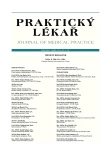Comparison of DXA and BIA in obese women indicated a sleeve gastrectomy – pilot study
Authors:
V. Zavadilová; M. Bužga
; Z. Jirák; A. Chroboková
Authors‘ workplace:
Ostravská univerzita v Ostravě, Lékařská fakulta, Děkan: doc. MUDr. Arnošt Martínek, CSc., Ústav fyziologie, Vedoucí: doc. RNDr. Pavol Švorc, CSc.
Published in:
Prakt. Lék. 2011; 91(12): 723-726
Category:
Of different specialties
Overview
Introduction:
Measurement of body fat is very important for assessing the severity of obesity, monitoring the effectiveness of its treatment and for motivating patients. There are various methods of body composition measurement that differ in accuracy, cost and time demands.
Methods:
The aim of this study was to compare body fat measured by Dual X-Ray Absorptiometry (DXA, device Hologic Discovery W) and by Bioelectrical Impedance Analysis (BIA, the device Nutriguard M) in obese women with indicated sleeve gastrectomy. The investigated individuals underwent
- body weight,
- height,
- waist, and
- hip measurement
and their BMI was calculated. A correction equation for the conversion of body fat percentage determined by BIA was created from selected monitored parameters, so that the results of this method were comparable to the results of the DXA reference method.
Results:
The sample consisted of 67 women aged 27 to 68 years. Average BMI was 42.3 ± 5.6 kg/m2. Subjects average amount of fat was 48.8 ± 4 % (DXA). Fat determined by BIA was on average 3.8 % lower (p <0.001). The correction formula for the conversion of body fat percentage observed by BIA, correlated with the method of DXA (r = 0,791 and showed on average, the same results in surveyed subjects as the method of DXA (p = 0.808).
Conclusion:
The results of body fat obtained by BIA in obese women were on average 3.8 % lower when compared with the DXA method. A correction equation for the conversion of body fat percentage determined by BIA and DXA was created. The correction equation created for this group of women gave the same results in body fat percentage as the DXA reference method.
Key words:
bioelectrical impedance analysis, DXA, sleeve gastrectomy, body composition, body fat percentage.
Sources
1. Bunc, V. Možnosti stanovení tělesného složení u dětí bioimpedanční metodou. Čas. Lék. čes., 2007, 146(5), s. 492-496.
2. Cruz-Jentoft, A.J., Baeyens, J.P., Bauer, J.M. et al. Sarcopenia: European consensus on definition and diagnosis. Age Ageing 2010, 39(4), p. 412-423.
3. Deurenberg, P. Limitatios of the bioelectrical impedance method for the assessment of body fat in severe obesity. Am. J. Clin. Nutr. 1996, 64, Suppl 3, p. 449-452.
4. Fakhrawi, D.H., Beeson, L., Libanati, C. et. al. Comparison of body composition by bioelectrical impedance and dual-energy X-ray absorptiometry in overweight/obese postmenopausal women. J. Clin. Densitom. 2009, 12, p. 238-244.
5. Fried, M., Hainer, V., Basdevant, A. et al. Interdisciplinary European guidelines on surgery of severe obesity. Obesity facts 2008, 1(1), p. 52-59.
6. Gibney, M.J., Macdonald, I.A., Roche, H.M. Nutrition and metabolism. 3rd edition. Oxford: Blackwell Publishing, 2006. 385 s. ISBN-13 : 978-0-632-05625-5.
7. Hainer, V. a kol. Základy klinické obezitologie. 2 vyd. Praha: Grada, 2011. 422 s. ISBN 978-80-247-3252-7.
8. Levitt, G.D., BeckmanM. L., Mager J.R. et al. Comparison of DXA and water measurements of body fat following gastric bypass surgery and a physiological model of body water, fat, and muscle composition. J. Appl. Physiol. 2010, 109, p. 786-795.
9. Loftin, M., Nichols, J., Going, S. et al. Comparison of the validity of anthropometric and bioelectric impedance equations to assess body composition in adolescent girl. Int. J. Body Compos. Res. 2007, 5(1), p. 1-8.
10. Mager, J.R., Sibley, S.D., Beckman, T.R. et al. Multifrequency bioelectrical impedance analysis and bioimpedance spectroscopy for monitoring fluid and body cell mass changes after gastric bypass surgery. Clin. Nutr. 2008, 27, p. 832-841.
11. R Development Core Team (2011). R: A language and environment for statistical computing. R Foundation for Statistical Computing, Vienna, Austria. ISBN 3-900051-07-0. Dostupné též na http://www.R-project.org/.
12. Thomson, R., Brinkworth, R.D., Buckley, J.D. et al. Good agreement between bioelectrical impedance and dual-energy X-ray absorptiometry for estimating changes in body composition during weight loss in overweight young women. Clin. Nutr. 2007, 26, p. 771-777.
13. Verdich, C., Barbe, P., Petersen, M. et al. Changes in body composition during weight loss in obese subjects in the NUGENOB study: Comparison of bioelectrical impedance vs. dual-energy X-ray absorptiometry. Diabetes Metab. 2011, 37, p. 222-229.
14. Větrovská, R., Lančňák, Z., Haluzíková, D. a kol. Srovnání různých metod pro stanovení množství tuku v, těle u žen s nadváhou a obezitou. Vnitř. Lék., 2009, 55(5), s. 455-461.
15. Všetulová, E., Bunc, V. Využití bioimpedanční metody pro stanovení procenta tělesného tuku obézních žen. Čas. Lék. čes., 2004, 143, s. 528-532.
16. Zamrazilová, H., Hlavatý, P., Dušátková, L. a kol. Nová jednoduchá metoda stanovení viscerálního a trunkálního tuku pomocí bioelektrické impedance: srovnání s magnetickou rezonancí a duální rentgenovou absorpciometrií u českých adolescentů. Čas. Lék. čes., 2010, 149(9), s. 417-422.
Labels
General practitioner for children and adolescents General practitioner for adultsArticle was published in
General Practitioner

2011 Issue 12
- Advances in the Treatment of Myasthenia Gravis on the Horizon
- What Effect Can Be Expected from Limosilactobacillus reuteri in Mucositis and Peri-Implantitis?
- Hope Awakens with Early Diagnosis of Parkinson's Disease Based on Skin Odor
- Metamizole in perioperative treatment in children under 14 years – results of a questionnaire survey from practice
- Memantine Eases Daily Life for Patients and Caregivers
Most read in this issue
- Ulcerogenic corticosteroids – the persisting myth among Czech doctors
- Classification of techniques to cope with craving
- Deficit Fluid Volume rating by nurses according to the diagnostic cues of nursing diagnosis
- Interstitial lung diseases in questions and answers
